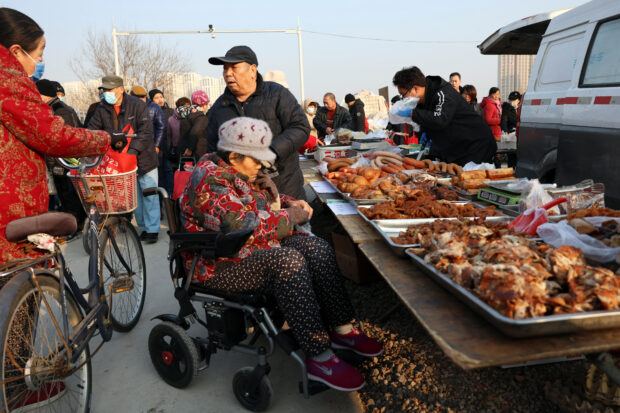
Elderly people chat next to a food stall at an outdoor market in Beijing, China Jan 12, 2024. REUTERS/Florence Lo/File Photo
BEIJING —China‘s consumer prices suffered their steepest fall in more than 14 years in January while producer prices also dropped, underscoring the persistent deflationary risks facing the world’s second-biggest economy as it struggles to recover.
The consumer price index (CPI) fell 0.8 percent in January from a year earlier, after a 0.3 percent drop in December, data from the National Bureau of Statistics (NBS) showed on Thursday. The CPI rose 0.3 percent month-on-month from a 0.1 percent uptick the previous month.
Economists polled by Reuters had forecast a 0.5 percent fall year-on-year and a 0.4 percent gain month-on-month. The annual CPI decline in January was the biggest since September 2009.
The world’s second-biggest economy has struggled to regain momentum since the end of COVID curbs in late 2022. It started this year on a lower ebb, with an official survey showing factory activity contracting in January as confidence remains weak amid a property downturn, local government debt risks and soft global demand.
Grappling slowing prices
“The CPI data today shows China faces persistent deflationary pressure,” said Zhiwei Zhang, chief economist at Pinpoint Asset Management.
“China needs to take actions quickly and aggressively to avoid the risk of deflationary expectation to be entrenched among consumers.”
China has been grappling with slowing prices since early last year, forcing policymakers to cut interest rates to spur growth even as many developed economies were focused on taming stubbornly high inflation.
READ: China’s Q4 GDP shows patchy economic recovery, raises case for stimulus
The economy grew 5.2 percent in 2023, meeting the official target of around 5 percent , but the recovery has been shakier than investors had expected. Policy insiders expect Beijing to maintain a growth target similar to last year of around 5 percent .
China‘s central bank in late January announced the deepest cut to bank reserves in two years, sending a strong signal of support for the fragile economy but analysts say policymakers need to do more to lift confidence and demand.
Core inflation, which strips out volatile food and energy prices, gained 0.4 percent from a year earlier, down from a 0.6 percent gain in December.
READ: China’s factory activity contracted more than expected in Dec
CPI rose 0.2 percent last year, missing the official target of around 3 percent , marking the actual inflation undershot annual targets for the 12 straight year.
Mild reflation seen in 2024
Citigroup economists said in a research note last week that they expect mild reflation in 2024, and forecast annual CPI inflation at 1.2 percent year-on-year.
“The cyclical drivers for CPI could turn around in 2024, while the strength of its reflation would hinge on the return of consumer confidence.”
The producer price index (PPI) slid 2.5 percent from a year earlier in January after a 2.7 percent fall the previous month, compared with a 2.6 percent slide forecast in the Reuters poll.
Factory-gate prices were down 0.2 percent from a month earlier, after falling 0.3 percent in December.
Prolonged factory deflation is threatening the survival of smaller Chinese exporters who are locked in relentless price wars for shrinking business.

